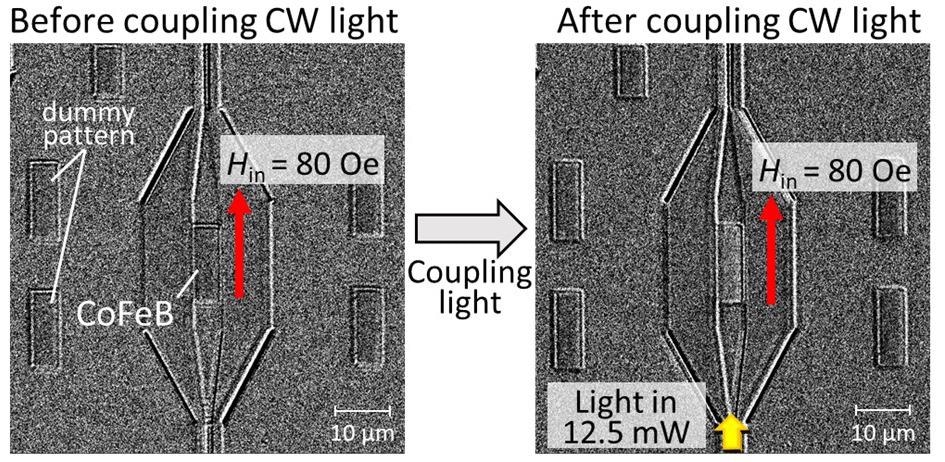Reviewed by Alex SmithMay 11 2022
For the first time, scientists have illustrated light-induced thermomagnetic recording in a magnetic thin-film on silicon waveguides. The writing method could lead to miniature greater performance magneto-optical memories without the need for bulky optics or mechanical rotation.
 The researchers demonstrated light-induced thermomagnetic recording for the first time. The magnetic direction changes direction after light is coupled into the magnetic area of the CoFeB magnetic film on the silicon waveguide. Image Credit: Toshiya Murai, Tokyo Institute of Technology.
The researchers demonstrated light-induced thermomagnetic recording for the first time. The magnetic direction changes direction after light is coupled into the magnetic area of the CoFeB magnetic film on the silicon waveguide. Image Credit: Toshiya Murai, Tokyo Institute of Technology.
Magneto-optical storage devices store data by combining optical and magnetic recording techniques. Even though rewritable magneto-optical disc drives were once widely available, they are now rarely used.
Despite their significant advantages, magneto-optical drives have been replaced by cheaper flash drives or optical storage media such as DVDs. Because our new recording method can be implemented using silicon photonics, it could enable inexpensive magneto-optical devices that store large amounts of information on a small chip.
Toshiya Murai, Research Team Leader, Tokyo Institute of Technology
The devices are nonvolatile, which means that data is secured even when the device is turned off, and they can withstand many writing and rewriting cycles. The researchers detailed their new magneto-topical memory devices and light-based writing technique in a study published in the Optica Publishing Group journal Optics Express.
On-chip magneto-optical memories could facilitate all-optical alternatives to today’s telecommunications infrastructure’s electronic packet routers.
This would eliminate the energy and expense required for optical-electrical-optical conversions and enable flexible communication for each data packet. Magneto-optical memories could also offer bit-level storage for optical computers, which use light for processing, storing and transferring data.
Toshiya Murai, Research Team Leader, Tokyo Institute of Technology
Controlling Magnetism with Light
Heat is used to demagnetize a tiny spot on a magnetic film beyond a critical temperature known as the Curie point in magneto-optical memory devices. When the location cools, a locally applied magnetic field identifies the magnetization direction.
Controlling the magnetic state of a magnetic film inside a waveguide with light propagating through the waveguide is required to perform this form of thermomagnetic recording in a photonic integrated circuit.
The investigators devised a technique to reverse the magnetization direction by heating the magnetic recording film to close the Curie temperature using light propagating in the waveguide. Their method makes it simple to align the material's magnetization with the direction of the applied external magnetic field.
The team created a silicon waveguide with a thin-film magnet to illustrate the new technique. They were able to evaluate the film’s magnetic properties for different optical powers using a high-resolution magneto-optical Kerr effect (MOKE) microscope. This enabled them to demonstrate that the magnet’s coercive force on the silicon waveguide is influenced by the heat generated by light guided in the waveguide.
When light was launched into the waveguide, we observed that the magnetization direction would flip under a proper biasing magnetic field. Thus, we demonstrated light-induced thermomagnetic recording integrated on a silicon photonic platform.
Toshiya Murai, Research Team Leader, Tokyo Institute of Technology
The investigators intend to use the new method to create solid-state magneto-optical recording systems that could not only write but also read information on a silicon photonic platform. This will necessitate lowering the energy consumption of light-induced thermomagnetic recording, which could be accomplished by combining a smaller magnetic recording medium with a shorter light pulse.
Journal Reference:
Murai, T., et al. (2022) Light-induced thermomagnetic recording of thin-film magnet CoFeB on silicon waveguide for on-chip magneto-optical memory. Optics Express. doi.org/10.1364/OE.448460.